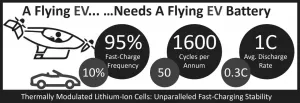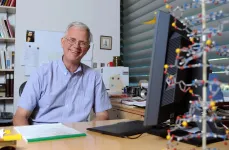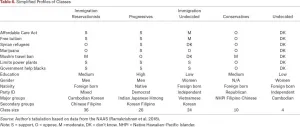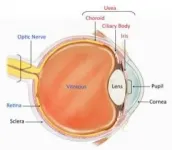Innovative batteries put flying cars on the horizon
2021-06-07
(Press-News.org) Jet packs, robot maids and flying cars were all promises for the 21st century. We got mechanized, autonomous vacuum cleaners instead. Now a team of Penn State researchers are exploring the requirements for electric vertical takeoff and landing (eVTOL) vehicles and designing and testing potential battery power sources.
"I think flying cars have the potential to eliminate a lot of time and increase productivity and open the sky corridors to transportation," said Chao-Yang Wang, holder of the William E. Diefender Chair of Mechanical Engineering and director of the Electrochemical Engine Center, Penn State. "But electric vertical takeoff and landing vehicles are very challenging technology for the batteries."
The researchers define the technical requirements for flying car batteries and report on a prototype battery today (June 7) in Joule.
"Batteries for flying cars need very high energy density so that you can stay in the air," said Wang. "And they also need very high power during take-off and landing. It requires a lot of power to go vertically up and down."
Wang notes that the batteries will also need to be rapidly recharged so that there could be high revenue during rush hours. He sees these vehicles having frequent take-offs and landings and recharging quickly and often.
"Commercially, I would expect these vehicles to make 15 trips, twice a day during rush hour to justify the cost of the vehicles," said Wang. "The first use will probably be from a city to an airport carrying three to four people about 50 miles."
Weight is also a consideration for these batteries as the vehicle will have to lift and land the batteries. Once the eVTOL takes off, on short trips the average speed would be 100 miles per hour and long trips would average 200 miles per hour, according to Wang.
The researchers experimentally tested two energy-dense lithium-ion batteries that can recharge with enough energy for a 50-mile eVTOL trip in five to ten minutes. These batteries could sustain more than 2,000 fast-charges over their lifetime.
Wang and his team used technology they have been working on for electric vehicle batteries. The key is to heat the battery to allow rapid charging without the formation of lithium spikes that damage the battery and are dangerous. It turns out that heating the battery also allows rapid discharge of the energy held in the battery to allow for take offs and landings.
The researchers heat the batteries by incorporating a nickel foil that brings the battery rapidly to 140 degrees Fahrenheit.
"Under normal circumstances, the three attributes necessary for an eVTOL battery work against each other," said Wang. "High energy density reduces fast charging and fast charging usually reduces the number of possible recharge cycles. But we are able to do all three in a single battery."
One entirely unique aspect of flying cars is that the batteries must always retain some charge. Unlike cellphone batteries, for example, that work best if fully discharged and recharged, a flying car battery can never be allowed to completely discharge in the air because power is needed to stay in the air and to land. There always needs to be a margin of safety in a flying car battery.
When a battery is empty, internal resistance to charging is low, but the higher the remaining charge, the more difficult it is to push more energy into the battery. Typically, recharging slows as the battery fills. However, by heating the battery, recharging can remain in the five- to ten-minute range.
"I hope that the work we have done in this paper will give people a solid idea that we don't need another 20 years to finally get these vehicles," said Wang. "I believe we have demonstrated that the eVTOL is commercially viable."
INFORMATION:
Also working on this project were Xiao-Guang Yang and Shanhai Ge, both assistant research professors in mechanical engineering, and Teng Liu, doctoral student in mechanical engineering, all at Penn State; and Eric Roundtree, EC Power, State College, Pennsylvania.
The U.S. Department of Energy's Office of Energy Efficiency and Renewable Energy, the U.S. Air Force Small Business Technology Transfer program and the William E. Diefenderfer Endowment funded this research.
[Attachments] See images for this press release:

ELSE PRESS RELEASES FROM THIS DATE:
2021-06-07
Bdelloid rotifers are multicellular animals so small you need a microscope to see them. Despite their size, they're known for being tough, capable of surviving through drying, freezing, starvation, and low oxygen. Now, researchers reporting in the journal Current Biology on June 7 have found that not only can they withstand being frozen, but they can also persist for at least 24,000 years in the Siberian permafrost and survive.
"Our report is the hardest proof as of today that multicellular animals could withstand tens of thousands of years in cryptobiosis, the state of almost completely arrested metabolism," says Stas Malavin ...
2021-06-07
The aurora borealis, or northern lights, that fill the sky in high-latitude regions have fascinated people for thousands of years. But how they're created, while theorized, had not been conclusively proven.
In a new study, a team of physicists led by University of Iowa reports definitive evidence that the most brilliant auroras are produced by powerful electromagnetic waves during geomagnetic storms. The phenomena, known as Alfven waves, accelerate electrons toward Earth, causing the particles to produce the familiar atmospheric light show.
The study, published online June 7 in the journal Nature Communications, concludes a decades-long quest to demonstrate experimentally the physical mechanisms for the acceleration of electrons by Alfven waves under ...
2021-06-07
What The Study Did: In this study, short-term effectiveness of the first dose of the BNT162b2 (BioNTech/Pfizer) vaccine against SARS-CoV-2 infection 13 to 24 days after immunization in a real-world setting was assessed.
Authors: Gabriel Chodick, Ph.D., of the Maccabi Institute for Research & Innovation, Maccabi Healthcare Services, in Tel Aviv, Israel, is the corresponding author.
To access the embargoed study: Visit our For The Media website at this link https://media.jamanetwork.com/
(doi:10.1001/jamanetworkopen.2021.15985)
Editor's Note: Please see the article for additional information, including other authors, author contributions and affiliations, ...
2021-06-07
What The Study Did: Among children with a COVID-19 diagnosis, researchers in this study examined what other conditions are common and which are associated with severe COVID-19 illness.
Authors: Lyudmyla Kompaniyets, Ph.D., of the U.S. Centers for Disease Control and Prevention in Atlanta, is the corresponding author.
To access the embargoed study: Visit our For The Media website at this link https://media.jamanetwork.com/
(doi:10.1001/jamanetworkopen.2021.11182)
Editor's Note: Please see the article for additional information, including other authors, author contributions and affiliations, conflict of interest and financial disclosures, ...
2021-06-07
What The Study Did: Researchers analyzed conversations on public Facebook groups to explore automated misinformation.
Authors: John W. Ayers, Ph.D., M.A., of the University of California, San Diego, in LaJolla, is the corresponding author.
To access the embargoed study: Visit our For The Media website at this link https://media.jamanetwork.com/
(doi:10.1001/jamainternmed.2021.2498)
Editor's Note: The article includes conflict of interest and funding/support disclosures. Please see the article for additional information, including other authors, author contributions and affiliations, conflict of interest and financial ...
2021-06-07
La Jolla, Calif. (June 07, 2021) -- "The coronavirus pandemic has sparked what the World Health Organization has called an 'infodemic' of misinformation," said Dr. John W. Ayers, a scientist who specializes in public health surveillance. "But, bots --like those used by Russian agents during the 2016 American presidential election-- have been overlooked as a source of COVID-19 misinformation."
A new study published in JAMA Internal Medicine led by Dr. Ayers, Co-Founder of the Center for Data Driven Health and Vice Chief of Innovation within the Division of Infectious Diseases ...
2021-06-07
While DNA provides the genetic recipe book for biological form and function, it is the job of the body's proteins to carry out the complex commands dictated by DNA's genetic code.
Stuart Lindsay, a researcher at the Biodesign Institute at ASU, has been at the forefront of efforts to improve rapid DNA sequencing and has more recently applied his talents to explore the much thornier problem of sequencing protein molecules, one molecule at a time.
In a new overview article, Lindsay's efforts are described along with those of international colleagues, who are applying a variety of innovative strategies for protein sequencing at the single-cell, and even single-molecule ...
2021-06-07
The recent attacks against Asian Americans have put Asians in the U.S. in the spotlight. Many of the victims are first-generation immigrants in ethnic communities, while those rallying for the victims are second-generation Asian Americans. A new Dartmouth study explores who Asian Americans are today and the range of identities this category encompasses.
The study, by END ...
2021-06-07
An international coalition of eye researchers used machine learning to develop classification criteria for 25 of the most common types of uveitis, a collection of over 30 diseases characterized by inflammation inside the eye. Together, these diseases are the fifth leading cause of blindness in the United States. The Standardization of Uveitis Nomenclature (SUN) Working Group, funded by the National Eye Institute (NEI), published its classification criteria in the American Journal of Ophthalmology. NEI is part of the National Institutes of Health.
"In the past, clinical research in the field of uveitis has been hampered by the lack of widely-accepted ...
2021-06-07
Lead is a toxic metal, and its widespread use has led to significant environmental pollution and public health problems in many parts of the world. This has led the WHO to include it on a list of ten chemicals that cause serious health problems. However, lead poisoning continues to affect many population groups. A study published today in open access in the journal Environment International found high levels of lead in indigenous people in Peruvian Amazonia living near areas where oil extraction takes place. The research was led by Cristina O'Callaghan-Gordo, a professor and researcher in Health Sciences Studies at the Universitat Oberta de Catalunya (UOC) and the Barcelona ...
LAST 30 PRESS RELEASES:
[Press-News.org] Innovative batteries put flying cars on the horizon





